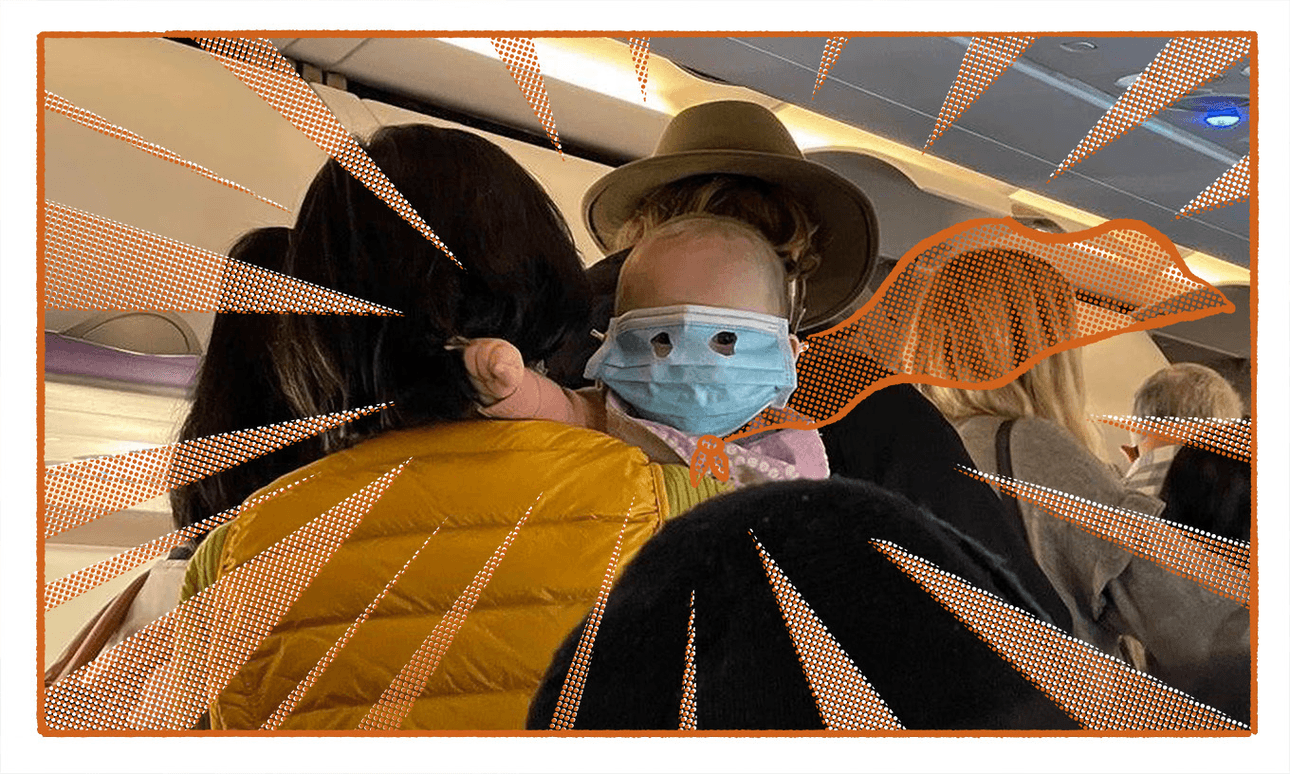An image of a masked-up baby on an Air New Zealand flight went viral over the weekend. Stewart Sowman-Lund has questions.
Gotham has Batman, Metropolis has Superman – now New Zealand has The Mask.
A figure of such mystique that nobody has been able to identify them.
It is also a baby.
An image of a masked child, held in the arms of a parent onboard an Air New Zealand flight, went viral after it was shared online over the weekend. But it wasn’t the fact this baby was wearing a mask that sent the internet into such a flurry. No, it was the way the mask was being worn: covering at least half the face and with two little eye holes cut out. Sort of like a masquerade mask but uniquely for the Covid-19 era.
The image of the child appears to have first shown up on the Reddit forum r/NewZealand. From there, it travelled to Instagram, and then to Twitter where it was posted by the page “images that MIGHT be cursed”. Cursed or not, I was intrigued. Should we all be cutting out little circles in our masks? What is The Mask hiding? Is this better than putting emojis over children to protect their identity? And did anyone else mistakenly think the hat of the man in front was being worn by the baby?
After cropping up on the Herald last night, the image attracted its fair share of both wonder and concern from readers. While many were simply in awe of the fashion statement being made, others expressed worry that the mask might not be offering much Covid protection on such a small child. So I went to Siouxsie Wiles, Covid communicator and microbiologist. I wanted to know: Is this how we should be protecting the next generation from the pandemic?
Wiles told me she had never encountered such a mask before. “Wow!” she responded, almost as soon as the image landed in her inbox. Despite some frankly sanctimonious comments from the public around the mask’s safety and efficacy, Wiles didn’t give it a complete fail grade in terms of its ability to keep a child safe from Covid. “I guess it might reduce the amount of virus they breathe in a little,” she said. “But probably best to invest in masks designed for little ones.” (Technically, during the orange traffic light setting, children under 12 are exempt from wearing a mask).
I still had more questions, so I tried to get in touch with the person who took the photo. According to the Herald, the photographer was a now-private Instagram user who was allegedly on the flight with The Mask – but I have my doubts as to whether they truly were responsible for the snap. A screenshot of their Instagram story was posted to Twitter on the afternoon of July 3 and it shows, very clearly, that they had splashed the word “mood” across The Mask’s forehead. That’s a detail missing from the image shared on Reddit and suggests editing of the original, rather than being the original. The Instagram user could not be reached for comment.
Additionally, the timing of the Twitter screenshot suggests the image was shared to Instagram around 6pm on July 2. The Reddit photo was posted at 1.53am on July 2, making it, definitively, the first documented evidence of The Mask. But I’m just asking questions.
Either way, I received no response from the Reddit user and I can’t message a private Instagram account. The trail was going cold and I still wanted to know more. I searched through the image’s metadata for clues, but found nothing (except a suspicious mention of a child’s head).
Nevertheless, based on the time of the Reddit post, I was able to deduce that the photo was taken sometime on July 1. And despite The Mask’s superhuman ability to maintain its secret identity, the photo left behind further telltale clues to its original Bruce Wayne-esque alter ego in the image.
Take a look, first, at the bottom left. The Mask may be sneaky, but they weren’t sneaky enough to take their complimentary edition of the Kia Ora magazine with them after leaving the flight. The inflight magazine can be seen tucked into the back pocket of the airline seat. While the publication date is not visible, a quick search reveals this is the July 2022 edition of the mag. Assuming the July edition would not be distributed to plane seats until the start of the month, this backs up the claim this photo was taken no earlier than July 1. (Air NZ did not respond to my request for comment).
The fact the Kia Ora magazine can be so clearly spotted at the top of the seat back also suggests there is no in-flight entertainment screen on the chair. This is a domestic flight. You can also spot the TV used for the safety video and in-flight quiz tucked up into the ceiling of the aircraft.
Not only is it a domestic flight, but it appears to be an Airbus A320 – the aircraft most commonly used on domestic routes between our biggest centres. And while no windows are visible in the picture, my bet is that this image was taken during daylight or evening hours. Nobody wants to fly with a baby during the night. (There also appears to be some natural light coming into the cabin).
Despite my investigation, I was no closer to any answers. Who was The Mask? What do they want? Are we safe? I may never know for sure. But I do know that in these confusing orange light, omicron-infused times – this is the hero New Zealand deserves, even if it’s not the one we need right now.
Are you the baby? Reach me on stewart@thespinoff.co.nz



